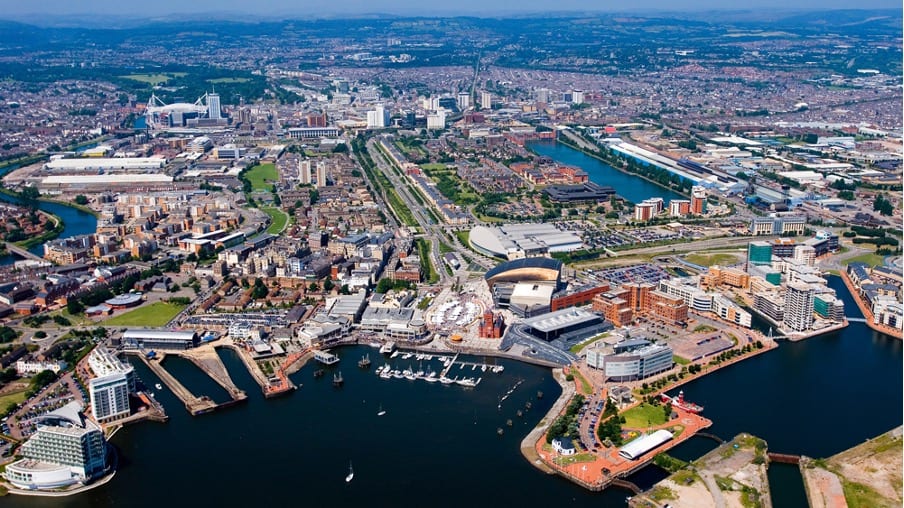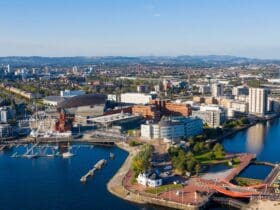Significant action is needed to upgrade and improve commercial real estate in the next 10 years to help Cardiff achieve the government’s net zero targets, according to new analysis by leading property consultancy JLL.
A new report, Sustainability and Value in the Regions, concludes that 75% of the office stock in Cardiff is at risk of not meeting the UK government’s target for all non-domestic properties to have an EPC B rating by 2030. However, Cardiff is ahead of many other leading regional centres in England and Wales, with the national figure standing at 90%.
Cardiff has committed to achieving net zero status by 2030, with the Wales capital’s council having set out its One Planet Strategy detailing how it plans to deliver a carbon neutral local authority.
With no completed office development across the eight UK regional centres having yet achieved the UK Green Building Council’s (UKGBC) embodied and operational net zero carbon standard, the research also finds that just 8% of total existing office stock in Cardiff is BREEAM Good to Outstanding, compared to 16% nationally. This shortfall is, however, expected to reduce significantly with the delivery of new development and refurbishment around the city centre.
JLL estimates that the UK’s rate of repurposing commercial stock needs to hit 5% annually in order to help the country hit its 2050 carbon neutrality goal, which would be more than double the levels of redevelopment seen in the last decade. Cardiff has one of the highest replacement rates out of the core regional office markets, currently standing at around 1.3%.
Cardiff’s newest office developments, such as John Street at Callaghan Square, Central Square and Central Quay are offering increased levels of sustainability, demonstrating the strong demand for commercial space that combines the highest quality fit-out and connectivity with minimal environmental impact, in terms of both construction and operational management.


The multi-million-pound redevelopment of Fusion Point One in Cardiff, completed earlier this year, included a new heating and cooling system to improve energy efficiency and environmental performance along with EV charge points, cycling provision and health club style shower rooms.
Building repurposing and refurbishments offer considerable sustainability benefits, such as Brewhouse, Central Quay, which, under current proposals, will transform the centuries-old brewery buildings into contemporary, highly sustainable workspace for businesses and entrepreneurs.
The office footprint of regional firms with science-based sustainability targets has more than tripled in the past three years to almost 4.5 million sq ft across the UK.
Justin Millett, lead director of the Cardiff office of JLL, said:
“It is encouraging to see that investors and occupiers are increasingly prioritising sustainability targets. There is certainly strong and growing demand in the market for offices that combine high quality design and fit-out as well as excellent connectivity with minimal environmental impact. Recent and current projects such as Fusion Point One, John Street at Callaghan Square, Central Square and Central Quay are helping to meet that demand.
“However, as our report shows, there is still a long way to go to ensure regional cities, including Cardiff, meet their goals. What’s changed is that this is now a commercial imperative, as well as an environmental necessity. For example, there’s a current active requirement in Cardiff from a blue-chip company looking for 70,000 sq ft carbon net zero office space, and at the moment the city is struggling to meet it.
“We need to drastically improve the environmental credentials of existing buildings, drive up the rate of repurposing existing stock where appropriate and, when building new, keep challenging ourselves and raising the bar. JLL, with our industry-leading sustainability team, can offer advice, guidance and project management in this area.”
Elaine Rossall, head of UK offices research at JLL, said:
“As COP26 has only served to reinforce, the next 10 years are imperative to the future of the planet. The built environment accounts for around 40% of all carbon emissions, but is even higher in many cities, meaning our cities and commercial centres must change or risk undermining any regional efforts – now set in stone in the carbon frameworks of most major cities – to achieve net zero status in the 2030s. This research indicates just how far short of those targets some regional office markets will be if, in addition to ongoing investment in new low carbon stock, the vast majority of existing offices aren’t improved via refurbishment or retrofit.”









Leave a Reply
View Comments